- About Dr. Paik
- Research
- Sponsored Research Projects
- Paik's Research Group
- Academic Honors and Awards
- Patents
- Publications
- Research Group News
- Other Academic Activities
Academic Qualification:
Ph.D. Department of Materials Science, Indian Institute of Technology Kanpur (IITK), India, 2008.
M. Tech. Materials Science, Indian Institute of Technology Kanpur (IITK), India, 2003.
B. Tech. Chemical Technology, University of Calcutta, India, 2001
B. Sc. (Chemistry Hons), Ramakrisna Mission Residential College, Narandrapur (University of Calcutta), 1998.
Professional Appointment:
7. 15th Nov, 2017-till date, Associate Professor, School of Biomedical Engineering, Indian Institute of Technology
(IIT) (BHU), Varanasi
6. 09th Feb, 2017-till date Associate Professor, School of Engineering Sciences and Technology, University of
Hyderabad (Central University)
5. 23rd Dec 2010-08th Feb, 2017, Assistant Professor, School of Engineering Sciences and Technology, University of
Hyderabad (Central University), since December 2010.
4. 2010-June-Dec 2010, Post Doctoral Research Fellow, National University of Singapore (NUS), Singapore,
Lab: Cellular and Molecular Bioengineering, Division of Bioengineering. Group: Prof. Zhang, Yong.
Research Areas: Novel Mesoporous Polymer Nanocapsules for Sustained Drug and Gene Delivery.
3. 2008-10 Post Doctoral Fellow, Institute for Nanotechnology and Advanced Materials, Department of Chemistry,
Bar-Ilan University, Israel. Group: Prof. Aharon Gedanken, and Prof. Yitzhak Mastai. 'Israel Science
Foundation' project, from 2008- 2010. Research Areas: Imprinting Chirality in Mesoporous Structures and its
Application in Chiral Resolution, Separation of Amino Acids and loading of Chiral drugs.
2. 2007 -08 Project Scientist: IIT Kanpur. Project Title: Nanocomposites.
1. 2003-08 Appointed as a Teaching Assistant at IIT Kanpur.
Research Experiences:
1. B. Tech. Dissertation, 6 months (January, 2001-June, 2001), University of Calcutta, India
2. M. Tech. Dissertation, 14 months (January, 2002-February, 2003), IIT Kanpur, India
3. Ph.D. Dissertation, 5 years, April, (2003-Nov, 2007), IIT Kanpur, India
4. Research Scientist, 3 months, (Dec, 2007-February, 2008), IIT Kanpur, India
5. Post doctoral experience: 2 years & 10 months, (March, 2008-Dec, 2010), Bar-Ilan University, Israel
and National University of Singapore, Singapore
6. Independent research group from Dec 2010-till date, IIT-BHU, Varanasi and University of Hyderabad, India
Members of the Editorial Board:
1. Editor: Special Issue on Nanomedicine: Nanotechnology, Biology and Medicine, June 2017
2. Editorial Board members: Journal of Engineering Technology (JET) (2014 onwards)
3. Guest Editor : The Scientific World Journal, for the special issue: Functional Nanomaterials and Their Applications
4. Associate Editorial Committee: Archives of Nanomedicine: Open Access Journal, Lupines Publishers
Dr. Paik's Group Key research areas: Health Care and Therapeutic Technology and Applications which includes:
- Nanomedicines and therapeutics, Bio-Polymers and Soft Bio-materials, Functional-Core-shell materials and Mesoporous materials for Nanobiotechnology and therapeutics,
- Nanocomposites, Hybrid nanomaterials and nanocapsules design and synthesis for drug and gene delivery,
- Designing of Carriers for drugs/cargoes for cancer treatment (Lungs and Breast), vaccination, etc.
- Health Care: Cancer therapy, Nano-Vaccination, Nano-Immunology, Tissue Engineering, Antibacterial Effects,
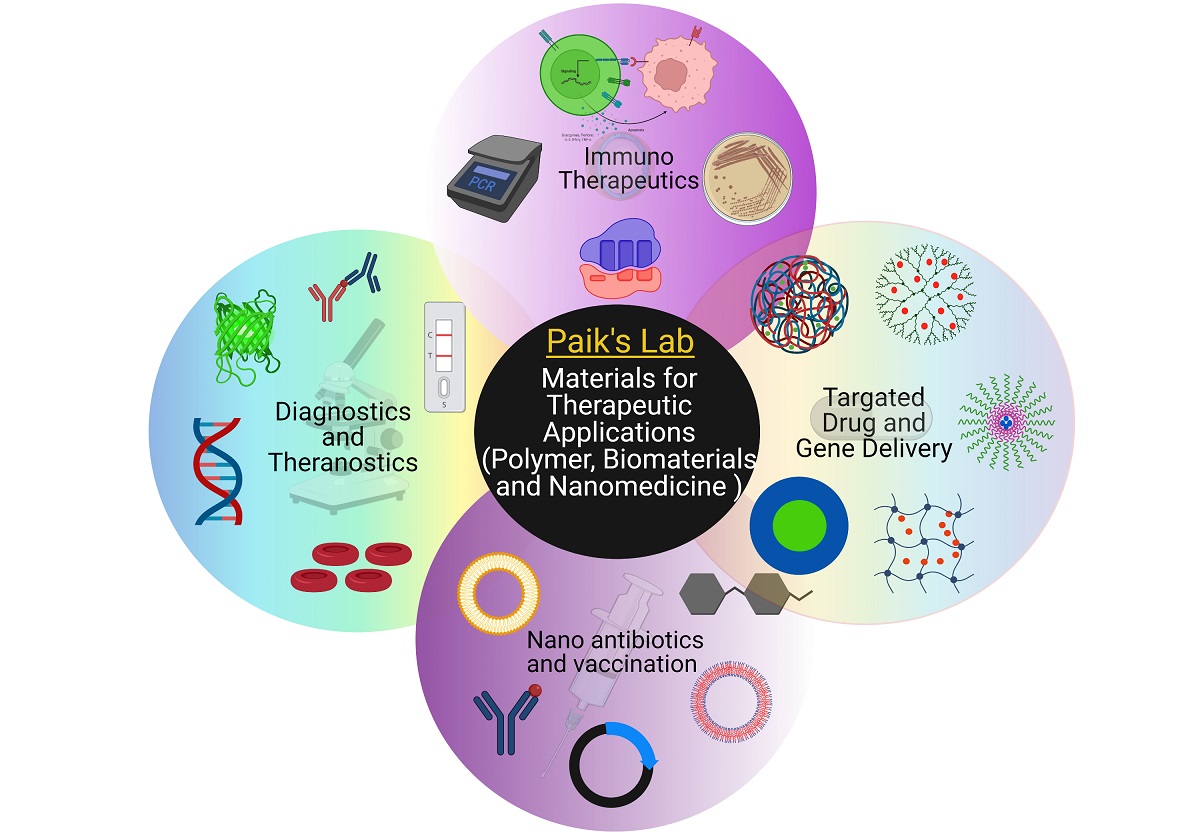
Important works from Research group and their research highlights:
1. Poly N-acryloyl-(L-phenyl alanine methyl ester) hollow nanocapsules facilitate sustained delivery of immunomodulatory drugs and exhibit adjuvant properties, Nanoscale, 2017,9, 14006-14014
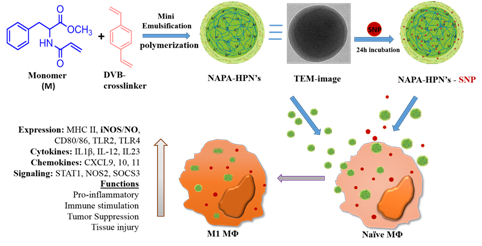
2. ZnO nanocapsules for the induction of enhanced antigen-specific immunological responses, Nanoscale, 2017 (Accepted, August, 2017), 10.1039/C7NR03697C
The application of nanotechnology in vaccinology have fuelled rapid advancement towards design and development of nanovaccines. Nanoparticles have been found to enhance the vaccine efficacy through precise size and exclusive capacity to encapsulate a wide range of biomolecules and their sustained release at the targeted sites. Herein, we have designed a novel mesoporous ZnO nanocapsule (mZnO) having size ~ 12nm with average pore diameter of 2.5nm, using surfactant-free sonochemical method and investigated its immunomodulatory properties by using Ova loaded mZnO nanocapsules[mZnO(Ova)] in a mice model. Our finding exemplifies that mZnO(Ova) administration steered enhanced expansion of antigen-specific T-cells and induction of IFN-γ producing effector CD4+ and CD8+ T-cells. Also, antigen-specific IgG levels were enriched in both serum and lymph nodes of mZnO(Ova) immunized mice. Further, we noticed a substantial increase in serum IgG2a or IgG2b levels and IFN-γ secretion in Ova restimulated splenocytes from mZnO(Ova) immunized mice, indicating that mZnO(Ova) skew Th1 type immune response. Overall, the uniqueness of mZnO nanocapsules in term of defined particle to pore numbers ratio (maximum of three cavities per particle), allows to load antigens efficiently. Given these features in combination with its immunomodulatory characteristics reinforces that mZnO could be used as an effective antigen-adjuvant platform for the development of novel nano-based vaccines against multiple disease.
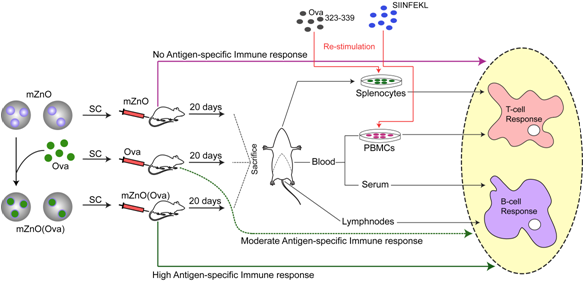
3. Bio-inspired synthesis of Hierarchical Self-Assembled Zinc phosphate nanostructure in presence of Cowpea Mosaic Virus: in vitro cell cycle, proliferation and prospective for tissue regeneration, Biomedical Materials 2017 Aug 8. doi: 10.1088/1748-605X/aa84e9.
Self-assembly is an important auto-organization process used in designing structural biomaterials which have potential capabilities in healing tissues after traumatic injuries. Notwithstanding, various materials with healing ability after injuries are available, substantial need still exists for developing new material to endorse the healing ability. To address this issue, we have developed a hierarchical 3-dimensional (3D) self-assembled zinc phosphate (Zn3(PO4)2) in presence of cowpea mosaic virus (CPMV). Zn3(PO4)2 nanoparticles are self-assembled into nanosheets with a high degree of isotropy and then self-organized into 3D structure having functionality that enhanced surface interactions with biological entities. The self-assembly structure has been formed through the auto organization of the nanoparticles of size ~50 nm in the influences of CPMV. The cellular response of self-assembled Zn3(PO4)2 and cell-particle adhesion behavior have been investigated through in vitro studies using modeled osteoblast-like MG63 cells. Self-assembled Zn3(PO4)2 resulted up to 310% cell proliferation with the MG63 cells within 7 days of incubation. A 15% higher in proliferation was obtained compared to the commercially available hydroxyapatite (HAp). Immunofluorescent analysis of MG63 cells after co-culturing with self-assembled Zn3(PO4)2 confirmed the healthy cytoskeleton organization and dense proliferation of MG63 cells. Further, Zn3(PO4)2 exhibited ~28% of cell-cycle progression in S phase, which is higher in value compared to the commercially available HAp. Overall, these results demonstrates the multiple functions of hierarchical self-assembled Zn3(PO4)2 to the regeneration of bone tissues without defects and with increasing the cellular network formation, and directed us for its use in bone tissue engineering. Keywords: Self-assembly nanoparticles; zinc phosphate; bio-synthesis; cowpea mosaic virus; cell proliferation; tissue engineering.
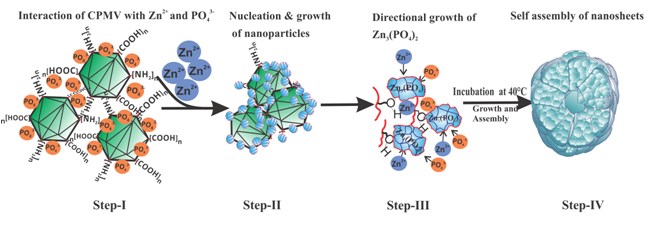
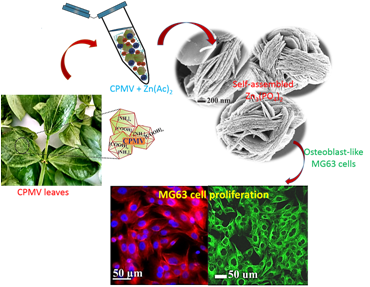
4. Designing idiosyncratic hmPCL-siRNA Nanoformulated Capsules for Silencing and Cancer Therapy, Nanomedicine: Nanotechnology, Biology, and Medicine 2016, 12(3)579-588. (IF: 6.692)
In this work, we have designed a siRNA-nanoformulation with mesoporous polycaprolactone (hmPCL) for silencing and cancer therapy. Average hollow core size of hmPCL nanocapsules used for nanoformulation is ~180 nm with shell thickness of 10-20 nm and mesopore size of ~5-10 nm in diameter. Idiosyncratic capsules are biocompatible which has been confirmed with normal lymphocyte, K562 leukaemia cancer cells and on HepG2/EGFP cancer cells. In 1 mg of hmPCL capsules up to 400 ng of siRNA can be loaded. This nanoformulation is enable to tune the dose dependent delivery up to ~93.25% (373 ng) siRNA during therapy. hmPCL-siRNA nanoformulation mediated siRNA transfection on HepG2 cancer cells has been investigated and exhibited 32% silencing activity within 24 hrs of post transfection. Obtained results directed us that the hmPCL-siRNA nanoformulation could be an efficient tool in siRNA mediated therapy for knocking down of the infected cells. KEYWORDS. Hollow-mesoporous-PCL nanocapsules, Nanoformulation, siRNA silencing, cancer therapy.
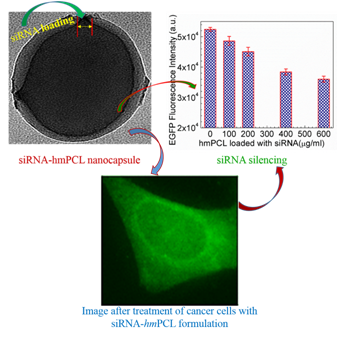
5. Nanoporous capsules of block co-polymer of [(MeO-PEG-NH)-b-(L-GluA)]-PCL for control release of anticancer drugs for therapeutic applications, Nanotechnology 27 (2016) 125101 (12pp). (IF: 3.573)
Herein, new nanoporous capsules of block co-polymers MeO-PEG-NH-(L-GluA)10 and polycaprolactone (PCL) have been synthesized through surfactant free, cost effective self-assembled soft-templating approach for control release of drugs and for therapeutic applications. Nanoporous polymer capsules designed are biocompatible and are capable of encapsulating anticancer drugs (e.g., doxorubicin hydrochloride (DOX) and imatinib mesylate (ITM)) with a high extent (~279 ng/µg and ~480 ng/µg, respectively). We have developed nanoformulation of porous MeO-PEG-NH-(L-GluA)10-PCL capsules with DOX and ITM. The porous polymer nanoformulations have been programmed in terms of release of anticancer drugs with a desired dose to treat the leukemia (K562) and human carcinoma cells (HepG2) in vitro and show promising IC50 values with a very high mortality of cancer cells (upto ~96.6%). Our nanoformulation arrests the cell divisions due to “cellular scenescence” and kill the cancer cells specifically. Present findings could be enriched the effectiveness of idiosyncratic nanoporous polymer capsules to use them in various other nanomedicinal and biomedical applications such as for killing cancer cells, immune therapy and gene delivery. Keywords: Polymer capsules, nanopores, nanomedicine, cancer therapy, DOX, ITM.
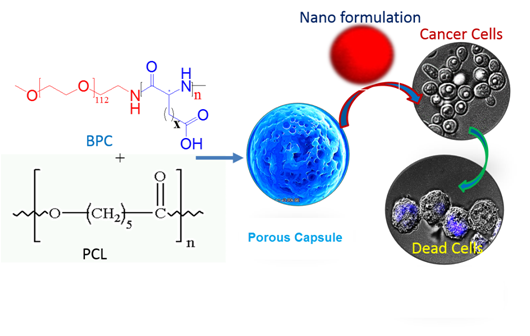
6. CPMV induced synthesis of Hollow-meso porous SiO2 Nanocapsules with excellent performance in Drug delivery, Dalton Trans., 2015,44, 4308-4317.
An idiosyncratic hollow porous-SiO2 nanocapsule has been synthesized at room temperature using unmodified Cowpea mosaic Virus (CPMV) as a template, and without using any catalyst or surfactant during synthesis. The average size of the capsules synthesized is ~200-250 nm with 60-100 nm hollow core these nanocapsules have been characterized through high resolution transmission electron microscopy (HRTEM). Biocompatibility of the hollow mesoporous SiO2 nanocapsules has been investigated with MTT assay using the RAW 264.7, HepG2 and Hek293 cell lines. Nanocapsules are loaded with fluorescent molecules (rhodamine 6G), doxorubicin (DOX) an anticancer drug and chloroqunine diphosphate (CQDP) an antimalarial drug and their release were studied through UV-Vis spectrometer. Development of surfactant free, bio-safe, hollow and porous SiO2 nanocapsules with CPMV has provided a route of synthesis of porous nanocapsules towards drug loading and sustained delivery of drugs. The synthesis method of hollow porous bio-SiO2 nanocapsules using CPMV is novel and straight forward, further demonstrating the generality of the nano-formulated capsules that can be used for various drug deliveries based therapeutic applications. To check the efficacy of our materials a non-cancerous cell lines Hek293 (human embryonic kidney cells) and HepG2 (human carcinoma cells) cell lines are used and studied the cell viability of DOX loaded hollow silica nanocapsules. Results show that our bio SiO2 nanocapsules synthesized with CPMV is an effective cargo in nano formulating with DOX and the resultant nanoformulation is very promising in killing cancer specific cells. Keywords: Cowpea mosaic virus, Hollow silica nanocapsules, Dye/Drug delivery.
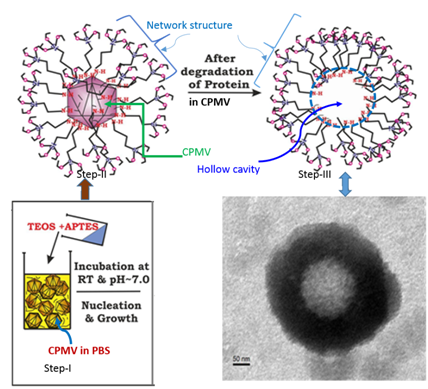
7. Facile Synthesis of Self-Assembled Spherical and Mesoporous Dandelion Capsules of ZnO: Efficient Carrier for DNA and Anti-cancer Drugs, J. Mater. Chem. B, 2014, 2, 3956-3964.
This work presents a new facile strategy to fabricate self-assembled spherical and mesoporous submicron-sized capsules, ‘dandelions’ of ZnO nanorods and nanoparticles. Self-assemble ‘dandelions’ capsules have been synthesized from Zn(Ac)2 and Igepal CO-520. The mechanistic approach for the growth of self-assembled ZnO capsules has been elucidated. Physical characteristics of the novel capsules responsible for biomedical applications have been studied through XRD, Raman, UV-Vis-NIR, XPS and EPR. The mechanical stability of the capsules has been characterized through the high energy ultrasound with time scale in 10% PBS buffer. The biocompatibility of the capsules has been investigated with a cell based study using normal lymphocyte and K562 cancer cells through MTT assay. The loading and release efficiency of the fluorescent molecules (Rhodanine 6G), anti-cancer drugs (doxorubicin hydrochloride, DOX), and nucleic acid (DNA) have been investigated. All the results indicate the high potential of self-assembled ZnO ‘dandelions’ capsules in relevant applications in medical biotechnology, such as for sustained drug delivery with the formation of {(ZnO)nᵟ+-(DOX)m} complex and gene delivery with the formation of {(ZnO)nδ+-(DNA)m complex formation. The fabrication of such type of self-assembled idiosyncratic capsules is very simple, feasible, and cost effective, and demonstrate improved performances in drug and gene delivery applications. Keywords: self-assembly, dandelion capsules, ZnO- mesopores, DNA, {(ZnO)nᵟ+-(DOX)m}.
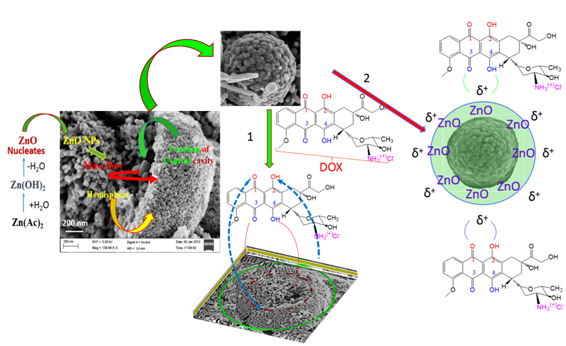
8. Malaria and Nanomedicine (Biomed. Phys. Eng. Express, https://doi.org/10.1088/2057-1976/aaaddb).
Plasmodium falciparum is resistant to all antimalarial drugs and a challenge for treatment. With this respect, formulations of antimalarial drugs with polymeric capsules with nanostructure carry a significant signature to suppress the resistance and to kill the Plasmodium falciparum. In this work, idiosyncratic hollow mesoporous polycaprolactone (ihmPCL) capsules were designed through ultrasonic-template synthesis approach with hollow core of dia. ca. ~ 450 nm and shell thickness of ca. ~30 nm and pore size of ca. ~ 8-9 nm. Then two formulations of ihmPCL capsules with Dihydroartemisinin (DHA) and Chloroquine diphosphate (CQDP) have been developed. ihmPCL capsules are capable to load 200.0 µg of DHA and 18.6 µg of CQDP per mg of capsules. With this formulation we can empowered to tune the doses of DHA and CQDP with time and temperature (30°C- 43°C). It is observed that up to 143.20 µg (~71.6 %) of DHA and 17.71 µg (~95.2 %) of CQDP release can be controlled at different essential conditions which further can be sustained for longer period of time. Further, the half-maximum inhibitory concentration (IC50) have been investigated with these formulations and calculated to be 66.60 nM and 25.14 nM for DHA and CQDP, respectively in P. falciparum inhibition in vitro. Based on the unique release behaviour of these antimalarial drugs a “temperature clock” module have been proposed for further accelerate the inhibition rate of P. falciparum infection. In conclusion, the PCL-DHA and PCL-CQDP formulations developed in this work could be effective in knocking down the P. falciparum infection and is paramount for treatment of malaria. KEYWORDS: Porous polymer capsules; nanoformulation; antimalarial drugs; P. falciparum; ‘temperature clock’.
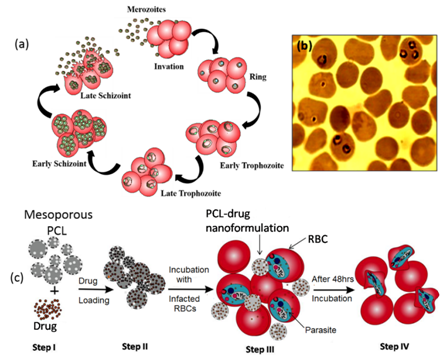
9. Silver nanoparticles embedded mesoporous SiO₂ nanosphere: an effective anticandidal agent against Candida albicans 077. Nanotechnology. 2015 Jul 17; 26(28):285102. doi: 10.1088/0957-4484/26/28/285102.
Candida albicans is a diploid fungus that causes common infections such as denture stomatitis, thrush, urinary tract infections, etc. Immunocompromised patients can become severely infected by this fungus. Development of an effective anticandidal agent against this pathogenic fungus, therefore, will be very useful for practical application. In this work, Ag-embedded mesoporous silica nanoparticles (mSiO2@AgNPs) have successfully been synthesized and their anticandidal activities against C. albicans have been studied. The mSiO2@AgNPs nanoparticles (d ∼ 400 nm) were designed using pre-synthesized Ag nanoparticles and tetraethyl orthosilicate (TEOS) as a precursor for SiO2 in the presence of cetyltrimethyl ammonium bromide (CTAB) as an easily removable soft template. A simple, cost-effective, and environmentally friendly approach has been adopted to synthesize silver (Ag) nanoparticles using silver nitrate and leaf extract of Azadirachta indica. The mesopores, with size-equivalent diameter of the micelles (d = 4-6 nm), were generated on the SiO2 surface by calcination after removal of the CTAB template. The morphology and surface structure of mSiO2@AgNPs were characterized through x-ray diffraction (XRD), Fourier-transform infrared spectroscopy (FTIR), particle size analysis (PSA), atomic force microscopy (AFM), field emission scanning electron microscopy (FESEM), Brunauer-Emmett-Teller (BET) and high-resolution transmission electron microscopy (HRTEM). The HRTEM micrograph reveals the well-ordered mesoporous structure of the SiO2 sphere. The antifungal activities of mSiO2@AgNPs on the C. albicans cell have been studied through microscopy and are seen to increase with increasing dose of mSiO2@AgNPs, suggesting mSiO2@AgNPs to be a potential antifungal agent for C. albicans 077.
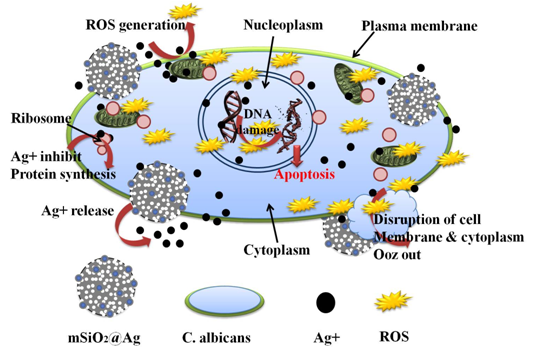
Colaboretor
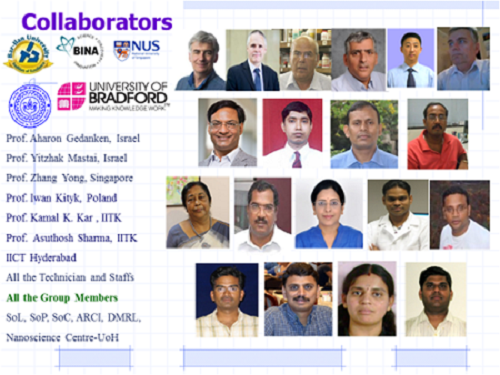
Research Projects:
Ongoing and Sanctioned:
- Functional-hollow-porous-biopolymer .................... Tuberculosis: concept of nanomedicine....................... MTB, DST Nano mission 2017-2020, ~57.00 Lakhs
- NSB....... Nanocapules and nanomedicine ...................................cancer therapy, (PI), DST-SERB, 2017-2020, 40.33 Lakhs
- Device fabrication of nanostructured ....................................: Performance evaluation with commercially available thermoelectric devices. DST-INPRINT, 2020-2023 (with IIT Kanpur) (Total value 250 Lakhs), co-Investigator
Projects Completed:
- Programming protective humoral responses with Nanoparticle based novel vaccine formulations against Dengue Virus, sanctioned March 2014 by DBT, (2014-2017) for 3 year, Rs. 64.15 Lakhs (Co-PI),
- Programming Protective Humoral responses with novel vaccine formulations against Dengue Virus (Co-PI), DST Nanomission, 2014-2017, 69.15 Lakhs
- Development of CPMV-block-copolymer Bioconjugate Nanoparticles and Synthesis of Functional Nanocapsules with High Stability for Medical Applications, Funded by DST(SERC/ET-0162/2011)-3 years, 19.44 Lakhs ( August, 2012-2016). (PI)
- Silicone Rubber Composites with inorganic fillers for Insulation applications, BHEL, 1 year, 17.15 Lakhs (Consultancy project, Started August, 2013). (PI), (2013-2016)
- PCL-Poly Amino acid based Nanomedicine for Co-treatment of Cancer and Tuberculosis, UPE-II network project, 3.5 Lakhs (Year 2015-2016)
- Photosensitive Mesoporous and Core-shell-polymer Nanoparticles Composites for Cancer Treatment, UPE-II, 3 lakhs (2012-2013)
- Identification of a novel anti-malarial drug target: study of Plasmodium falciparum TopoisomeraseVI, UPE-II, 3 lakhs (2012-13)
- Start-of-Grant -3 Lakhs, 2011, UOH
- Silicone Rubber Composites with inorganic fillers for Insulation applications, BHEL, 1 year, 17.15 Lakhs (Consultancy project, Started August, 2013), (PI), (2013-2014)
- XIth Plan budget for research facilities Development: (2011-2014, 125.00 Lakhs, UGC-UOH
- From IIT BHU, Varanasi:
A. Post Doctoral Fellows:
1. Dr. Munendra Singh Tomar (Ph.D. Zoology, BHU)
2. Dr. Monika Singh (Ph.D., Biomedical Engineering, IIT BHU)
3. Dr. Himadri Medhi (likely to be joined soon)
B. Ph.D. Scholars:
1. Kirti Wasnik (Pharmaceutics and Nanomedicine)
2. Prem Shankar Gupta ((Pharmaceutics and Nanomedicine)
3. Sukanya Patra (Chemistry and Biopolymers)
4. Rishi Ram (Mechanical Eng., Micro fluidics devices for Biomedical Application), due Dec. 2020 (Jointly)
5. Monika Pandey (Chemical Engineering, Antibacterials study)
6. Somedutta Maity (Biotechnology and Nanomedicines)
7. Divya Pareek (Micro Biology and DNA Technology)
C. M. Tech. Scholars:
1. Ms. Subhra Gupta
D. IDD Scholars:
1. Md. Arshad
2. Sandeep Singh
3. Sourav K. Jadav
4. Charan
5. Oviya
Visitors and Short term research scholars: (will be updated)
For any of the above position send email directly to Dr. Pradip Paik. Prospective candidates having GATE, NET, DST-INSIRE, ICMR fellow, DST-Fellow, CSIR-Fellow can send email directly to find about the available Ph.D. and for other positions. Those who are interested to apply for National postdoctoral fellowship, they can also communicate with CV.
Email: paik.bme@iitbhu.ac.in, pradip.paik@gmail.com
Research Scholars: (at University of Hyderabad):
-On-going Ph.D. Scholars: 2
1. Monica Pandey
2. Somedutta Maity
-Ph.D. Synopsis Submission:
-Ph.D. Thesis Submitted: 1 (awaiting for award)
1. Ms. Monami Das Modak (Physics, photonic materials)
-Ph.D. Degree Awarded: 8 (Eight)
1. Dr. Koushi Kumar
2. Dr. Santhosh Kumar
3. Dr. Alka Parek
4. Dr. Rajalaxmi Maharana
5. Dr. Chander A.
6. Dr. Himadri Medhi
7. Dr. Anil Kumar A.
8. Dr. Debasrita Bharatiya
- M. Tech.: Degree Awarded: 11
- M.Sc./M. Pharm: Degree Awarded: 2
Ph.D. Thesis guidance:
- Virus-polymer Bioconjugation for Drug Delivery-by Koushi Kumar
- Graphene-polymer-functional and Hybrid nanocomposites for Drug delivery – by Santhosh Kumar
- Amino acid based Polymeric Nanocapsules for Drug Delivery…Chander A.
- Synthesis of New Bio-Polymers and Their uses in making Nanomedicines by Anil Kumar
- Hydrophobic polymers Nanocapsules for Drug Delivery’, by Himadri Medhi
- Meta and Fluorescent Materials for Biomedical Applications …Monami Das Modak (regular)
- Polymeric Nanocapsules for Drug delivery…….Debasrita Bharatiya (regular)
- Nanocapsule from Plant Virus for Nanomedicines (regular) ..Monica Pandey (regular)
- Materials for Breast Cancer Treatment. By Somedutta Maity (regular)
Others Ph.D. Guidance:
- Investigations on stability and efficiency improvement of modified Cd-chalcogenide nanostructure hybrid composite film for photoelectrochemical H2 generation, by Alka Parek (Awarded 2016)
- Magnetic properties of amorphous AlPO4-Metal nanocluster composites for the applications in magnetic systems, by Rajalaxmi Maharana (Awarded 2017)
M. Tech. thesis guidance/completed -Awarded:
- ‘Core shell Nanostructure of PCL, PCL@SiO2, ZnO-SiO2 and Their Physical Properties and Biomedical Applications- completed by Vijay Bhooshon Kumar (completed on 2012
- Towards the Synthesis of ZnO/SiO2-ZnO Nanocapsules for Biomedical Applications, Saranaya Murali, 2012 (April), M. Sc.-Nano.
- synthesis and characterization of Graphene Oxide-Silica hybrid nanocomposite for Bio-Applications’, completed by Santhosh Kumar (Year 2012)
- Synthesis and Characterization of Porous Micro and Nanocapsules of Block Copolymers as a Potential Vector for Drug Delivery (Awarded, Dec 2013), by Chander A.
- ‘Studies on the Physical Properties of Conducting Polymer Nanofibers Dispersed Liquidcrystals’, (Awarded April 2014), by Ramesh Manda.
- “Polymeric Hollow Nanocapsule and Mesoporous Silica Nanoparticle as Drug Delivery System” Master of Pharmacy (Pharmaceutics), Department of Biotechnology and Bioinformatics, faculty of Pharmaceutical Sciences, University of Pune, 29-09-2014.
- Nanoformulation of Monodispersed Porous Polymer Nanocapsules for Sustained Drug Delivery (Awarded, July 2013), by Himadri Medhi.
- “Designing of Mesoporous hollow SiO2-ZnO Nano capsules and It’s Biomedical applications” – Awarded, 2016, Mr. Gopobandhu Panigrahi.
- “Complex nanostructures of Copper (II) Oxide dispersed and immobilized on Silica Template: Structure and antibacterial properties” – Awarded 2016, MR. Dhiman Bonik.
- Complex Metal and Alloy for Antibacterial Activities--- Ghunta Rajesh –Award due 2017 (July)
- 2020 "SITARE-Gandhian Young Technological Innovation (GYTI) Appreciations 2020" on Development of polymer based Nano medicine for the treatment of Cerebral Malaria
- 2020 Best Researcher Award in Engineering Science and Medicine, VGOOD PROFESSIONAL ASSOCIATION, Hyderabad, India
2019 Lecture Award: Materials Research Society (MRS), Trilateral (Singapore-China-India) Invited Lecture at Singapore, 21–23 November 2019 , (10th Trilateral Conference on Nanoscience: Energy, Water & Healthcare) - 2019 (Patent Awarded): Title: A process for the preparation of nanoparticles of high molecular weight of polystyrene (with Prof. Kamal K Kar, IIT Kanpur), dated awarded, 9th September, 2019, (Patent No. 320069).
- 2019 (August) Ms. Monami Das Modak, Best Paper Presentation Award Oral (1st Prize): for the paper “Optical Properties in Upconverting Nanoparticles (UCNPs)”, Third International Conference on Advanced Materials (ICAM 2019) 9-11 August 2019 at Mahatma Gandhi University, Kottayam, Kerala, India
- 2019 Monika Panday for BEST POSTER PRESENTATION Award in the conference in Fourth International Conference on Nanomaterials (ICN) 2019, 12th -14 April
- 2019 Debasrita Bharatia for BEST ORAL PRESENTATION AWARD, (Fourth International Conference on Nanomaterials (ICN) 2019, 12th -14 April)
2019 Monami Das Modak for the Best Poster Presentation Award, in 4th International Conference on Nanotechnology for Better Living to address polymers and their composites" at IIT Kanpur, 6th and 7th April, 2019. - 2018 VIRA 2018-OUTSTANDING SCIENTIST IN BIOMEDICAL ENGINEERING under the Engineering Discipline.( 4th Venus International Research Awards - VIRA 2018, 11th August)
- 2016-17 Associate Fellow in Engineering Sciences, Telangana Academy of Sciences,
2015 India International Science Festival- Young Scientists’ Meet Department of Science and Technology, Government of India –Dec 4-8, 2015, Paper Code: Mater 80. Expenditure (travel, registration, accommodation etc awarded)-Student name: Mr. Chander - 2015 Visiting Scientist, Institute for Nanotechnology and Advanced Materials, Department of Chemistry, Bar-Ilan University, Israel. (1.5 Months)
2014 Best oral presentation award (first) (Ms. Alka Pareek, Ph.D. scholar), International Conference on Environment and Energy (ICEE-2014), December 15th -17th 2014, JNTU, Hyderabad, (Authors name: Alka Pareek, Dr. Pradip Paik, Dr. P.H. Borse), Paper name: Electrochemical characterization of Ag loaded nano-titania modified CdS /polysulphide electrolyte interface. - 2014 Best paper presentation award, (Student Awarded,Ms. Alka Pareek, Ph.D. scholar) by Electrochemical Society, India
2013 Student awarded: Mr. Vijay Bhooshan Kumar (M.Tech. fellow) awarded Best Thesis Award for his M. Tech. dissertation by INAE, India.
2012 Visiting Scientist/Faculty, Institute for Nanotechnology and Advanced Materials, Department of Chemistry, Bar-Ilan University, Israel (December 2012, for 1 month), worked on mesoporous materials for Drug and gene delivery - 2011 Swarnaya Jayanty Endowment Fellowship, Indian Institute of Metal, August 2011
2011 ‘DST International Travel Grant for conference, August 2011, (Canada), “NANOPOROUS MATERIALS – VI” , which will held in Banff, Alberta, Canada on August 21-24, 2011. - 2011 ‘SERC Fast Track project for Young Scientists in Engineering Science’, Department of Science & Technology, India, August 2011
2007 'Young Scientist Award’ by Indian Science Congress Association (ISCA) in Materials Science, and Nanoscience and Nanotechnology, for the year of 2007-2008 - 2001 Qualified Graduate Aptitude Test for Engineers (GATE), Engineering Science. AIR: 127
Session Chairs: - Session Chair, IIT Kanpur, April 2019, 4th International Conference on Nanotechnology for Better Living to address polymers and their composites" at IIT Kanpur, 6th and 7th April, 2019.
- UGC sponsored Short term Course on “Bio-Nanotechnology”, JNTU, Hyderabad, 12-27/9/2014
- 26th European Conference on Biomaterials, University of Liverpool, Liverpool, 31st August – 3rd September 2014
- International Conference on Advanced Polymeric Materials (ICAPM 2013), October 2013, Mahatmagandgi University, Kottayam.
- International Conference on Nanomaterials and Nanotechnology’ (ICNANO2011), 18-21st December, 2011 at University of Delhi, Delhi, India.
Travel Grants Awarded:
- 2018 ‘SERB International Travel Grant for conference, ISBPPB 2018, July (15-18) 2018, Poland
2014 Centre for International Co-operation Science (CICS) (INSA-CSIR DAE/BRNS-CICS Travel Fellowship Scheme for ESB 2014, 31st August-3rd Sept 2014 (partial)–Liverpool, UK, By ICMR
2014 Travel grant by Indian Council for Medical Research (ICMR), New Delhi for ESB 2014, 31st August-3rd Sept 2014, Liverpool, UK
2011 ‘DST International Travel Grant for conference, August 2011, (Canada), “NANOPOROUS MATERIALS – VI” , which will held in Banff, Alberta, Canada on August 21-24, 2011. - 2011 Swarnaya Jayanti Endowment Fellowship, Indian Institute of Metal, August 2011, (Canada)
2011 ‘DST International Travel Grant for Young Scientist’ for conference, July 2011, Canada
2006 CSIR Travel Grant for attending conference in USA
2006 PerkinElmer Travel support (partial) for attending conference in USA
- Postdoctoral Research Awards:
2010 Research Fellow, NUS Singapore, Division of Bio-engineering, June to Dec 2010
2008-10 'Post-Doctoral Fellowship' in an 'Israel Science Foundation (ISF)' project in Israel, 2008-10
Research Papers Awards:
2007 Research paper cash award, by 'Department of Resource Planning and Generation (DRPG)', at IIT Kanpur, April, 2007
2007 Research paper cash award, by 'Department of Resource Planning and Generation (DRPG)', at IIT Kanpur, November, 2007
Fellowship Awarded:
2003-08 Scholarship of “Ministry of Human Resource and Development (MHRD)” for Ph.D.
2001-02 Scholarship of 'Ministry of Human Resource and Development (MHRD)' for M.Tech.
Other Awards and Recognitions:
1993-95 Jindal Trust Scholarship for HS (10+2) results
1993-95 District Magistrate Scholarship for HS (10+2) results
1992 & 93 Merit certificates: ‘Mathematical Talent Search Examination'
1992, 93 & 94 Merit certificates: ‘Science Talent Search Examination’
2017 (January) Judge for Avishkar-2016 (Maharashtra State)
2017 Ph.D. thesis Reviewer, AcSIR at CSIR-IIC
Patent Awarded:
(1) Title: A process for the preparation of nanoparticles of high molecular weight of polystyrene (with Prof. Kamal K Kar, IIT Kanpur), dated awarded, 9th September, 2019, (Patent No. 320069).
PATENTS FILLED
17. A mesoporous anti-microbial nanocomposite and a method of preparation thereof, Application No.: 202011031802, dated: July 24, 2020
16. Biocompatible nano-triblock-co-polymers and a process for their preparation, Application No.: 202011029248, (9th, July 2020)
15. Temperature sensitive porous polymer film for biomedical applications and a method of its synthesis, Application No.: 202011020948, May 18, 2020.
14. A method of synthesizing carbon dots and a product thereof, Application No.: 202011018557, Dated: 30th April, 2020
13. A nanomaterial based antimicrobial composition and a method of preparation thereof, Application no.: 202011017968, dated: April 27, 2020
12. A novel hydrogel with high mechanical stability and a method of making the same, (Ref. 201811045481, TEMP/E-1/49511/2018-DEL, December 1, 2018.
- -------------------------------------------------------------************-----------------------------------------------------------
11. Poly-N-Acryloyl L-Leucine Methyl Ester Hollow Nanocapsules (pLME) for Drug Delivery & Antibacterial Properties: Method of Fabrication and uses (Ref:
TEMP/E1/35596/2017CHE, dated, 02/10/2017)
10. Up-conversion nanoparticle dot (UCN–dot) of size 3.5 nm & its preparation process thereof. (Ref: TEMP/E-1/21071/2017CHE, dt.: 14/06/2017)
9. Stable up-conversion nanoparticle dendrimer (UCND) & method of making thereof. (Ref:TEMP/E-1/21065/2017CHE, dt.: 14/06/2017)
8. Stable up-conversion nanoparticle super lattice (UCN-SL) & in-situ process for developing thereof (Ref:TEMP/E-1/21071/2017CHE, dt.: 14/06/2017)
7. Green synthesis of biocompatible porous and hollow zinc phosphate nano capsules using cow pea mosaic virus (CPMV)” (Ref: 201641031985, dated: 20th Sept. 2016)
6. “Development of hollow nanoporous yolk shell nanocapsules from neem seed thereof” (Ref: 201641031995, dated: 20th Sept. 2016)
5. “A process for preparation and design of unique nano porous polymeric capsules of (MeO-PEG-NH)-b-(L-GluA)-PCL thereof” (Ref: 201641031990, dated: 20th Sept. 2016)
----------------------------------------------------------------****---------------------------------------------------------------------
4. A process for preparation of nanoparticles of high molecular weight of polystyrene, Inventors: Kamal Krishna Kar and Pradip Paik, References: 1136/DEL/2013, Date: 17th
April, 2013
3. Title: A process for preparation of nanoparticles of high molecular weight of polypropylene, Inventors: Kamal Krishna Kar and Pradip Paik, References: 1135/DEL/2013, Date:
17th April, 2013
2. Kamal K Kar and Pradip Paik ‘A Process for Preparation of micron sized High molecular weight Polymer,’ Indian Pat. Appl. (2006), 94pp; Application: IN 2004-DE2503,
20041216.
1. Kamal K Kar and Pradip Paik ‘High molecular weight Nano sized Polyethylene, Polypropylene and Polystyrene: Controlled Preparation and its Characterization,’ Indian
Pat. Appl. (2007), 39pp, Application: IN 2005-DE3161, 20051125.
Books:
- Synthesis and Characterization of Nanopolymers: Polypropylene, Polyethylene and Polystyrene, by Pradip Paik, ISBN: 978-3-659-29646-8, LAP LAMBERT Academic Publishing GmbH & Co. KG, Heinrich-Böcking-Str. 6-8, 66121, Saarbrücken, Germany (2013)
Book Chapters:
- “Polystyrene Nanospheres”, in the book “Developments in Nanocomposites”, (accepted, June, 2011), Singapore, Editors: Prof. Kamal K. Kar & Dr. Alma Hodzic, (ISBN : 978-981-08-3711-2) ‘Advanced Polymer Nanoparticles: Synthesis and Applications’, Pradip Paik and V. B. Kumar, (Accepted, 2011)
- ‘Advanced Polymer Nanoparticles: Synthesis and Applications’, in the book “Developments in Nanocomposites”, (Accepted, October, 2011), Singapore, Editors: Prof. Kamal K. Kar & Dr. Alma Hodzic ISBN : 978-981-08-3711-2, Pradip Paik and V. B. Kumar, (Accepted, 2011)
- ‘POLYMERS FOR DRUG DELIVERY SYSTEMS’, in Book “Nanotechnology in Animal Health and Production, Chander A., Koushi Kumar, Himadri Medhi, Pradip Paik, ISBN: 9789351243182, Astral International (P) Ltd. New Delhi, Year 2014.
Ten Important Publications (recent)
- Himadri; Maity, Somedutta; Suthram, Niranjan; Chalapareddy, Suresh ; Bhattacharyya, Mrinal ; Paik, Pradip Hollow mesoporous polymer capsules with Dihydroartemisinin and Chloroquine diphosphate for knocking down Plasmodium falciparum infection, Biomed. Phys. Eng. Express, https://doi.org/10.1088/2057-1976/aaaddb
- Anil Kumar Yamala, Vinod Nadella, Yitzhak Mastai, Hridayesh Prakash and Pradip Paik, Poly N-acryloyl-(L-phenyl alanine methyl ester) hollow nanocapsules facilitate sustained delivery of immunomodulatory drugs and exhibit adjuvant properties, Nanoscale, 2017,9, 14006-14014 (I.F.: 7.8)
- Sumbul Afroz, Himadri Medhi, Somedutta Maity, Gillipsie Minhas, Srikanth Battu, Jeevan Giddaluru, Koushi Kumar, Nooruddin Khan and Pradip Paik ; ZnO nanocapsules for the induction of enhanced antigen-specific immunological responses, Nanoscale, 2017,9, 14641-14653
- Vijay Bhooshon Kumar, Himadri Medhi, Yong Zhang, Pradip Paik, Designing idiosyncratic hmPCL-siRNA Nanoformulated Capsules for Silencing and Cancer Therapy, Nanomedicine: Nanotechnology, Biology, and Medicine 2016, 12(3)579-588. (IF: 6.692)
5. Chander Amgoth, Gangappa Dharmapuri, Arunasree M. Kalle and Pradip Paik, Nanoporous capsules of block co-polymer of
[(MeO-PEG-NH)-b-(L-GluA)]-PCL for control release of anticancer drugs for therapeutic applications, Nanotechnology 27 (2016)
125101 (12pp). (IF: 3.573)
- Sudip Mukherjee, Bonda Rama Rao, Sreedhar B, Pradip Paik and Chittaranjan Patra, Copper Prussian blue analogue: Investigation into multifunctional activities for biomedical applications, Chem. Commun., 2015,51, 7325-7328. (IF: 6.567)
- Koushi Kumar, Arunasree MK. Pradip Paik, CPMV induced synthesis of Hollow-meso porous SiO2 Nanocapsules with excellent performance in Drug delivery, Dalton Trans., 2015,44, 4308-4317. (IF: 4.177)
- Vijay Bhooshon Kumar, Aharon Gedanken, Pradip Paik. Facile Synthesis of Self-Assembled Spherical and Mesoporous Dandelion Capsules of ZnO: Efficient Carrier for DNA and Anti-cancer Drugs, J. Mater. Chem. B, 2014, 2, 3956-3964. (IF: 4.872)
- Satarupa Pattanayak, Amiya Priyam and Pradip Paik, Facile tuning of plasmon bands in hollow silver nanoshells using mild reductant and mild stabilizer, Dalton Trans., 2013,42, 10597-10607. (IF: 4.177)
- Pradip Paik, Yong Zhang, Synthesis of Hollow and Mesoporous Polycaprolactone Nanocapsules, Nanoscale, 2011, 3, 2215-2219. (IF: 7.760)
Complete List of PUBLICATIONS in PEER Reviewed Journals:
77. Koushi Kumar and Pradip Paik, Bio-mimicked and CPMV-imprinted hollow porous Zinc phosphate nanocapsules and its therapeutic efficiency, ACS Appl. Bio Mater. 2020, 3, 9, 6005–6014 (Accepted, 24th August, 2020), https://doi.org/10.1021/acsabm.0c00634.
76. Monami Das Modak, Ganesh Damarla, K. Santhosh Kumar, Somedutta Maity, Anil K. Chaudhury and Pradip Paik, Upconverting nanodots of nayf4yb3er3 synthesis characterization and uv visible luminescence study through ti sapphire 140 femtosecond laser pulses, arXiv:2008.06783, (2020), 18th August, 2020,
(http://arxiv.org/abs/2008.06783).
75. Prerna Sinha; Amit Yadav; Alekha Tyagi; Pradip Paik; Hiroyuki Yokoi; Amit Naskar; Tapas Kuila, Kamal K. Kar, Keratin-derived functional carbon with superior charge
storage and transport for high-performance supercapacitors, Carbon, 168 (2020) 419e438420 (accepted, 1st July, 2020)
74. Himadri Medhi, Saratchandra Singh Khumukcham, Bramanandam Manavathi, Pradip Paik*, Effective in vitro delivery of Paclitaxel by nanocargo of mesoporous
Polycaprolactone against triple negative breast cancer cells by minimalizing drug dose, RSC Adv., 2020,10, 24095-24107 (Published, 24 Jun 2020).
73. A novel hydrogel with high mechanical stability and a method of making the same, Application No.: 201811045481 (December 1, 2018), (The Patent Office Journal No.
23/2020, Indian Patent Office published on June 05, 2020).
72. Up-conversion nanoparticle dot (UCN–dot) of size 3.5 nm & its preparation process thereof. (Ref: TEMP/E-1/21071/2017CHE, dt.: 14/06/2017, Application No.
201841037608A, Published: (The Patent Office Journal No. 15/2020, Indian Patent Office published on 10-04-2020).
71. Stable up-conversion nanoparticle dendrimer (UCND) & method of making thereof. (Ref: TEMP/E-1/21065/2017CHE, dt.: 14/06/2017), Application No.
201841037609A, Published: (The Patent Office Journal No. 15/2020, Indian Patent Office published on 10-04-2020).
70. Stable up-conversion nanoparticle super lattice (UCN-SL) & in-situ process for developing thereof (Ref:TEMP/E-1/21071/2017CHE, dt.: 14/06/2017), Application No.
201841037607A, Published: (The Patent Office Journal No. 15/2020, Indian Patent Office, published on 10-04-2020).
69. Dhiman Banik, S Chennakesavulu, Monika Singh, Nidhi Pandey, Ragini Tilak, Aramati Bindu Madhava Reddy, Pradip Paik,*, mesoporous x[Cu(II)O] nanoclusters
dispersed and immobilized on y[Sio2] matrix: structure and effective controlled biocidal activity against pseudomonas, aeruginosa and bacillus subtilis, Bulletin of
Materials Science, 2020,43(39), 1-8
68. Monika Singh, Divya Somvanshi, Rajesh Kumar Singh, Govinda Kapusetti, Arun Kumar Mahanta, Pralay Maiti, Pradip Paik and Nira Misra, “Functionalized Poly vinyl
chloride/Layered Double Hydroxide Nanocomposite and its thermal and mechanical properties" Journal of Applied Polymer Science, 2020, 84494(1-12).
67. Anil Kumar Yamal, Vinod Nadella, Yitzhak Mastai, Hridayesh Prakash Pradip Paik*, p-LME Polymer Nanocapsules stimulatenaïve macrophages and protect them from
oxidative damage during controlled release of drug", Journal of Applied Polymer Science, 2020, 137(6) 48363 (1 of 12)
--------------------------------------------------------------------- (2019) ---------------------------------------------------------------
66. Monami Das Modak, Ganesh Damarla, Somedutta Maity, Anil K. Chaudhary and Pradip Paik, “Self-assembled Pearl-necklace patterned upconverting nanocrystals with
highly efficient blue and ultraviolet emission: femtosecond laser based upconversion properties", RSC Adv., 2019, 9, 38246-38256 (Accepted, 15.11.2019)
65. Alekha Tyagi; Amit Yadav; Prerna Sinha; Shashank Singh; Pradip Paik; Kamal K. Kar, Chicken feather rachis: An improvement over feather fiber derived
electrocatalyst for oxygen electroreduction, Applied Surface Science, Applied Surface Science, 2019, 495 (30) 2019, 143603.
64. Varma, Gajapati; Kummari, Githavani; Paik, Pradip; Kalle, Arunasree, Celecoxib potentiates antibiotic uptake by altering membrane potential and permeability in
Staphylococcus aureus, Journal of Antimicrobial Chemotherapy, 2019 Dec 1;74(12):3462-3472.
63. Debasrita Bharatiy, K. Santhosh Kumar, Raghunandan Seelaboyina, Pradip Paik*, A detailed study on the dielectric properties of CCTO@SiO2 core-shell
nanoparticles: Role of SiO2-NH2 shell over CCTO core surface, Journal of Solid State Chemistry, 2019, (277), 346-355 (September, 2019)
62. Debasrita Bharatia, Santhosh Kumar, S Raghunandan and Pradip Paik* Dielectrics of the noble synthesized nanocomposite silica coated CCTO over
Graphene oxide with the efficacy of CCTO@SiO2 NPs decoration", Journal of Materials Science, 2019, 54(8), 6272–6285.
61. Poly-N-Acryloyl L-Leucine Methyl Ester Hollow Nanocapsules (pLME) for Drug Delivery & Antibacterial Properties: Method of Fabrication and uses
(Ref: TEMP/E1/35596/2017CHE, dated, 02/10/2017), Application No. 201741034846A. Published: (The Patent Office Journal No. 14/2019, Indian Patent Office
published on 05-04-2019)
**********************************************(2018)******************************************
60. Pradip Paik*, K. Santhosh Kumar, Monami Das Modak, Koushi Kumar U and Somedutta Maity, UCN–SiO2–GO: a core shell and conjugate system for
controlling delivery of doxorubicin by 980 nm NIR pulse, RSC Adv., 2018,8, 37492-37502.
59. Alka Pareek, Pradip Paik, Joydip Joardar, K.Murugan, Pramod H. Borse, Fabrication of conducting polymer modified CdS photoanodes for photoelectrochemical
cell, Thin Solid Films, (2018), 661, 84-91
cell, Thin Solid Films, (2018), 661, 84-91
58. Medhi, Himadri; Maity, Somedutta; Suthram, Niranjan; Chalapareddy, Suresh ; Bhattacharyya, Mrinal ; Paik, Pradip* Hollow mesoporous polymer capsules with
Dihydroartemisinin and Chloroquine diphosphate for knocking down Plasmodium falciparum infection, , Biomed. Phys. Eng. Express, 2018, 4, 035006.
57. Green synthesis of biocompatible porous and hollow zinc phosphate nanocapsules using cow pea mosaic virus (CPMV)” (Application No. 201641031985, dated: 20th
Sept. 2016), Published: (The Patent Office Journal No. 12/2018, Indian Patent Office published on 23-3-2018)
56. “Development of hollow nanoporous yolk shell nanocapsules from neem seed thereof” (Ref: 201641031995, dated: 20th Sept. 2016), Published: (The Patent Office
Journal No. 12/2018, Indian Patent Office published on 23-3-2018)
55. “A process for preparation and design of unique nano porous polymeric capsules of (MeO-PEG-NH)-b-(L-GluA)-PCL thereof” (Ref: 201641031990, dated: 20th Sept.
2016), Published: (The Patent Office Journal No. 12/2018, Indian Patent Office published on 23-3-2018)
*****************************************(IIT-BHU, 2017)***************************************
54. Satarupa Pattanayak, Abhishek Swarnkar, Pradip Paik and Amiya Priyam, Seed Geometry and Hydrogen Bonding Dependent Plasmonic Tuning of Silver
Nanocrystals in Citrate-Hydrazine Matrix and SERS Spectroscopic Detection of Chromium, RSC Adv., 2017, 7, 45911-45919. (IF: 3.1) (26th Sept, 2017).
- Anil Kumar Yamala, Vinod Nadella, Yitzhak Mastai, Hridayesh Prakash and Pradip Paik*, Poly N-acryloyl-(L-phenyl alanine methyl ester) hollow nanocapsules facilitate sustained delivery of immunomodulatory drugs and exhibit adjuvant properties, Nanoscale, 2017,9, 14006-14014 (I.F.: 7.8) (August 2017)
- Sumbul Afroz, Himadri Medhi, Somedutta Maity, Gillipsie Minhas, Srikanth Battu, Jeevan Giddaluru, Koushi Kumar, Pradip Paik* and Nooruddin Khan; ZnO nanocapsules for the induction of enhanced antigen-specific immunological responses, Nanoscale, 2017,9, 14641-14653 (August, 2017)
- Santhosh Kumar K, Monami Das Modak and Pradip Paik* Graphene Oxide for Biomedical Applications, J Nanomed. Res, 2017, 5(6): 00136. DOI: 10.15406/jnmr.2017.05.00136, (I.F: waiting) (July 12, 2017)
- Koushi Kumar, Vasudeva Rao Penugurti, Gila Levi, Yitzhak Mastai, Bramanandam Manavathi and Pradip Paik*,, Bio-inspired synthesis of Hierarchical Self-Assembled Zinc phosphate nanostructure in presence of Cowpea Mosaic Virus: in vitro cell cycle, proliferation and prospective for tissue regeneration, Biomed. Mater., 2017, 13, 015013 (I.F: 3.44) (7th December 2017)
********************* (Associate Professor appointment, UOH, 9th Feb, 2017)************************
- Vijay Bhooshon Kumar, Himadri Medhi, Yong Zhang, Pradip Paik*, Designing idiosyncratic hmPCL-siRNA Nanoformulated Capsules for Silencing and Cancer Therapy, Nanomedicine: Nanotechnology, Biology, and Medicine 2016, 12(3)579-588. (IF: 6.692)
48. Chander Amgoth, Gangappa Dharmapuri, Arunasree M. Kalle and Pradip Paik, Nanoporous capsules of block co-polymer of [(MeO-PEG-NH)-b-(L-GluA)]-
PCL for control release of anticancer drugs for therapeutic applications, Nanotechnology 27 (2016) 125101 (12pp). (IF: 3.573)
47. Vijay Bhooshon Kumar, Pradip Paik, Twining ZnO nanoparticles to nanorods with control growth and size-shape dependent interactions with cancer cells: physical
properties matter to up-take of cancer cells, Advanced Materials Letters, 7th Dec 2016 (DOI: 10.5185/amlett.2017.6474), (IF: 1.2)
46. Sudip Mukherjee, Bonda Rama Rao, Sreedhar B, Pradip Paik and Chittaranjan Patra, Copper Prussian blue analogue: Investigation into multifunctional activities for
biomedical applications, Chem. Commun., 2015,51, 7325-7328. (IF: 6.567)
45. Koushi Kumar, Arunasree MK. Pradip Paik*, CPMV induced synthesis of Hollow-meso porous SiO2 Nanocapsules with excellent performance in Drug delivery, Dalton
Trans., 2015,44, 4308-4317. (IF: 4.177)
44. Vijay Bhooshon Kumar, Aharon Gedanken, Pradip Paik. Facile Synthesis of Self-Assembled Spherical and Mesoporous Dandelion Capsules of ZnO: Efficient Carrier for
DNA and Anti-cancer Drugs, J. Mater. Chem. B, 2014, 2, 3956-3964. (IF: 5.02)
43. Qasim, Mohd; Ananthaiah, J.; Dhara, S.; Paik, P.; Das, D. Synthesis and Characterization of Ultra-Fine Colloidal Silica Nanoparticles, Advanced Science, Engineering
and Medicine, 2014, 6, 965-973( Number 9, September 2014, pp. 965-973(9))
42. Qasim M, Singh BR, Naqvi AH, Paik P, Das D. Silver nanoparticles embedded mesoporous SiO₂ nanosphere: an effective anticandidal agent against
Candida albicans 077. Nanotechnology, 2015 26(28), 285102(IF: 3.787)
41. A. Pareek, P. Paik, and P. H. Borse, Stable Hydrogen Generation from Ni and Co based co-catalysts supported CdS PEC Cell, Dalton Trans., 2016,
45, 11120-11128., (IF: 4.177)
40. Alka Pareek, H. G. Kim, Pradip Paik and Pramod H. Borse, Ultrathin MoS2-MoO3 nanosheets functionalized CdS photoanodes for effective charge
transfer in a photoelectrochemical (PEC) cell, Journal of Materials Chemistry A 5 (4), 1541-1547 (2017) (accepted Dec 2016, Accepted Manuscript,
DOI: 10.1039/C6TA09122A, (IF: 11.3)
39. Pareek, Alka; Kim, Hyun Gyu; Paik, Pradip; Joardar, Joydip; Borse, Pramod, Nano-architecture based photoelectrochemical water oxidation efficiency
enhancement by CdS photoanodes; Materials Research Express 4 (2), 026203, 2017, Accepted. Jan. 2017, (Article reference: MRX-103515) (IF: )
38. K. Santhosh Kumar, Pradip Paik, High Dielectric Constant SiO2 Nanoparticles” Advanced Materials Proceedings, 1(1), 114-117, 2016, (IF :)
37. K Santhosh Kumar, Srinath Sanyadanam and Pradip Paik, Dangling ultrafine nano silica on graphene oxide to form hybrid nanocomposite: enhancement of
dielectric properties, Materials Research Express, 055019(1-15), 3(5) 2016. (IF :)
36. Rajalaxmi Maharana, V. V. Bhanu Prasad, Durga Prasad, Koushi Kumar, Neha Hebalkar, Pradip Paik, Subir Roy, Synthesis of high temperature stable carbon coated
metal nanoparticles in AlPO4 based matrix in-situ in oxidative atmosphere, Journal of the American Ceramic Society 2016, 99(1),64-71. (IF: 2.787)
35. K. Santhosh Kumar and Pradip Paik, A New Single/Few-layered Graphene Oxide with a high Dielectric Constant of 106: Contribution of defects and functional groups,
RSC Adv., 2015, 5, 14768-14779. (IF: 3.289)
34. A Pareek, P Paik, PH Borse, Role of transition metal-hydroxide (M-OHx, M= Mn, Fe, Ni, Co) co-catalyst loading: efficiency and stability of CdS photoanode, MRS Proc
2015, 1776, 1-5
33. Alka Pareek, Pradip Paik and Pramodh H. Borse, Nano-niobia Modification of CdS photoanode for an Efficient and Stable Photoelectrochemical cell, Langmuir 2014, 30,
15540−15549. (IF: 3.993 )
32. Mohd Qasim, J. Ananthaiah, S. Dhara, P. Paik, and D. Das, Synthesis and Characterization of ultra-fine colloidal silica nanoparticles, Adv. Sci. Eng. Med. 6, 965-973
(2014). (IF:0.98 )
31. M. V. Rasna, K. P. Zuhail, R. Manda, P. Paik, S Dhara, Bistable conductivity and Photothermal Switching of liquid crystal conducting polymer composites,
Phys. Rev. E 89, 052503, 2014. (IF: 2.288)
30. Rajalaxmi Maharana, M. Manivel Raja, V.V. Bhanu Prasad , Pradip Paik, Subir Roy, Synthesis and studies of magnetic properties of high temperature stable Ni
nanoparticles in nearly amorphous AlPO4 matrix in oxidative atmosphere, J. Mater. Chem. C, 2014, 2, 5142-5148. (IF: 5.066)
29. A. Pareek, P. Paik and P.H. Borse, Characterization of Nano-Titania Modified CdS /Polysulfide Electrolyte Interface by Utilizing Mott Schottky and Electrochemical
Impedance Spectroscopy, Electroanalysis 2014, 26, 2403 – 2407. (IF: 2.872)
28. Alka Pareek, Rahul Purbia, Pradip Paik, Neha Y. Hebalkar, · Hyun Gyu Kim, · Pramod H. Borse, Stabilizing effect in nano-titania functionalized CdS photoanode for
sustained hydrogen generation, International Journal of Hydrogen Energy, 2014, 2014, 39(9), 18 4170–4180. (IF: 3.313)
27. Ramesh Manda, K. Santhosh Kumar, A. Chandar, Pradip Paik, Polyaniline Nanotubes with Rectangular-Hollow-Core and its Self-assembled Surface Decoration: high
conductivity and dielectric properties, RSC Adv., 2014, 4, 12342-12352. (IF: 3.289)
26. Kamal K Kar, Pradip Paik, "A process for preparation of nanoparticles of higher molecular weight of polyethelene", Indian Patent Application Number
3161/DEL/2005, Dated: 25-Nov-2005, Patent Number 260562, PG Journal Number 19/2014, Grant Date: 08-May-2014, Publication date: 09-May-2014
25. Vijay Bhooshan Kumar, Aharon Gedanken, Pradip Paik, Triangular Core–Shell ZnO@SiO2 Nanoparticles, ChemPhysChem, 2013 14 (14), 3215-3220
24. R. Manda, V. Dasari, P. Satayanarayana, N. V. Rasna, S. Dhara, P. Paik, Possible enhancement of physical properties of nematic liquid crystals by doping of conducting
polymer nanofibres, Applied Physics Letter, 2013, 103, 141910. (IF: 3.142)
23. Vijay Bhooshan Kumar, Madhavi Annamanedi, Muvva Durga Prashad, Kalle M. Arunasree, Yitzhak Mastai, Aharon Gedanken, Pradip Paik, Synthesis of Mesoporous
SiO2-ZnO Nanocapsules: Encapsulation of Small Bio-molecules for Drugs and ‘SiOZO-plex’ for Gene Delivery, Journal of Nanoparticle Research, 2013, 15:1904
(page 1-13)( Accepted, 26th July, ). (IF: 2.278)
22. Satarupa Pattanayak, Amiya Priyam and Pradip Paik, Facile tuning of plasmon bands in hollow silver nanoshells using mild reductant and mild stabilizer, Dalton
Trans., 2013,42, 10597-10607. (IF: 4.177)
21. K. Santhosh Kumar, Vijay Bhooshan Kumar, and Pradip Paik, Recent Advancement in Functional Core-Shell Nanoparticles of Polymers: Synthesis,
Physical Properties and Applications in Medical Biotechnology (review Article), Journal of Nanoparticles. 2013, Vol (2013)1-24 pages, Article ID 672059,
(http://dx.doi.org/10.1155/2013/672059). (IF:2.009 )20. Pradip Paik, Yitzhak Mastai, Iwan Kityk, Piort Rakus, Aharon Gedanken, Synthesis of amino acid block-copolymer imprinted chiral mesoporous silica and its
acoustically-induced optical Kerr effects, Journal of Solid State Chemistry, 2012, 192, 127-131. (IF: 2.133)
19. P. Suresh Kumar, Pradip Paik, D. Mangalaraj, Aharon Gedanken, D. Nataraj, Biodegradability study and pH Influence on growth and orientation of ZnO
nanorods via aqueous solution Process, Applied Surface Science, 2012, 258, 6765–6771. (IF: 6.2)
18. Pradip Paik, Yong Zhang, Synthesis of Hollow and Mesoporous Polycaprolactone Nanocapsules, Nanoscale, 2011, 3, 2215-2219. (IF: 7.760)
**********************************************************************************************
17. Pradip Paik, Aharon Gedanken and Yitzhak Mastai, Chiral-mesoporous-polypyrrole Nanoparticles: Its Chiral Recognition Abilities and Use in Enantioselective
Separation, Journal of Materials Chemistry, 2010, 20, 4085-4093. (IF: 6.626)
16. Pradip Paik, Aharon Gedanken and Yitzhak Mastai, Chiral Separation Abilities: Aspartic Acid Block Copolymer-imprinted Mesoporous Silica, Microporous and
Mesoporous Materials, 2010, 129, 82-89. (IF: 3.349)
15. Pradip Paik, Aharon Gedanken and Yitzhak Mastai, Enantioselective Separation Using Chiral Mesoporous Spherical Silica Prepared by Templating of Chiral Block
Copolymers, ACS Applied Materials & Interfaces, 2009, 1(8), 1834-1842. (IF: 8.758)
14. Pradip Paik and Kamal K. Kar, 'Polypropylene Nanosphere: Particle Size and Crystal Structure, International Journal of Plastics Technology, 2009, 13(1), 68-82. (IF:
)
13. Pradip Paik and Kamal K. Kar, Thermal Degradation Kinetics and Estimation of Lifetime of Polyethylene Particles: Effects of Particle Size, Materials Chemistry and
Physics, 2009, 113, 953–961. (IF: 4.4)
12. Pradip Paik and Kamal K. Kar, Surface Roughness and Morphology of Polypropylene Nanospheres: Effects of Particles Size, Surface Engineering, 2008, 24(5), 341-
349. (IF:2.23 )
11. Pradip Paik and Kamal K. Kar, Kinetics of Thermal Degradation and Estimation of Lifetime for Polypropylene Particles: Effects of Particle Size, Polymer Degradation
and Stability, 2008, 93, 24-35. (IF: 3.553)
10. Pradip Paik and Kamal K Kar, High Molecular Weight Polyethylene Nanospheres: Synthesis Physical and Mechanical Properties, Journal of Nanoscience and
Nanotechnology, 2008, 8, 3123-3135. (IF: 1.6)
9. Pradip Paik, Kamal K. Kar, Dinesh Deva and Ashutosh Sharma, Measurement of Mechanical Properties of Polymer Nanospheres by Atomic Force Microscopy: Effects
of Particle Size, Micro & Nano Letters, 2007, 2(3), 72-77. (IF: 1.5)
8. Pradip Paik and Kamal K. Kar, High Molecular Weight Polypropylene Nanospheres: Synthesis and Characterization, Journal of Applied Polymer Science, 2007,
105(3), 1133-1143. (IF:2.51)
7. Pradip Paik and Kamal K. Kar. Physical and mechanical properties of high molecular weight polystyrene nanoparticles. ANTEC - Society of Plastics Engineers, 2010,
68, 1724-1728. (IF: )
6. Pradip Paik and Kamal K. Kar. ‘High Molecular Weight (MW) Nano Sized Polyethylene (PE): Effect of Particle Size, Macro-Micro-Nano,’ ANTEC - Society of Plastics
Engineers, 2007, 65th, 542-547 (in USA). (IF: )
5. Pradip Paik and Kamal K. Kar. ‘Glass Transition Temperature of High Molecular Weight Polystyrene: Effect of Particle Size, Bulk to Micron to Nano,’ NSTI Nanotech,
2006, 1, 483-486 (in USA). (IF: )
4. Kamal K. Kar; Pradip Pradip; Suresrao, A. S. and Otaigbe, Joshua U. ‘Scanning Electron microscopy, Spectroscopy and Viscoelastic Studies of Nano Low Density
Polyethylene,’ ANTEC - Society of Plastics Engineers, 2004, 62 (2), 2505-2509, (in USA). (IF: )
3. Kamal K. Kar; Pradip Pradip Kumar, Rakesh; and Otaigbe, Joshua U. ‘Synthesis and Characterization of Nano-polystyrene: Effect of Temperature, Shear Rate and
Solvents,’ ANTEC - Society of Plastics Engineers, 2004, 62 (2), 2500-2504, (in USA). (IF: )
2. Kamal K. Kar; Pradip Pradip; Otaigbe and Joshua U. ‘Characterization of Structure and Viscoelastic Properties of Polypropylene Nanopolymer,’ ANTEC - Society of
Plastics Engineers, 2004, 62 (2), 2495-2499, (in USA). (IF: )
1. Kamal K. Kar; Pradip Pradip and Otaigbe, Joshua U. ‘Synthesis and Characterization of Nanopolymer: High Density Polyethylene,’ ANTEC - Society of Plastics
Engineers, 2004, 62 (2), 2490-2494. (IF: )
- More coverage of our work in cancer therapy, NANOMEDICINES etc.: You can read them to learn about our research ACTIVITIES:
The Hindu:
The Times of India:
The Hans India:
The Deccan Chronicle:
UoH Herald:
News Nations:
Southern Express:
http://southernexpress.in/university-hyderabad-researchers-develops-nano-capsules-cancer-treatment/
- Research News: (on malaria treatments etc)
- http://www.thehindu.com/todays-paper/tp-national/tp-andhrapradesh/Young-scientists-to-get-awards/article14905104.ece
- http://www.sciencecongress.nic.in/young_scientists_awards_07-08.php
- http://www.thehindu.com/todays-paper/tp-features/tp-educationplus/Indian-Science-Congress-2008-a-mixed-bag/article15402743.ece
- http://www.tasc.org.in/associate-fellows.html
- http://uohherald.commuoh.in/uoh-faculty-invited-to-bar-ilan-university-in-israel/
- http://www.thehansindia.com/posts/index/Hans/2015-06-15/UoH-faculty-invited-as-Visiting-Scientist-to-Israel/157388
- https://www.thehindubusinessline.com/news/science/university-of-hyderabad-researchers-develop-nano-medicine-to-treat-malaria-parasite/article22857594.ece
- http://www.thehansindia.com/posts/index/Telangana/2018-02-25/Hyderabad-varsity-researchers-develop-nanomedicine-for-malaria-treatment/361488
- http://uohherald.commuoh.in/a-new-invention-polymer-based-nanomedicine-for-treatment-of-malaria/
- https://www.deccanchronicle.com/lifestyle/health-and-wellbeing/250218/nanomedicine-for-malaria-treatment.html
- https://www.thehindubusinessline.com/news/variety/hyderabad-varsity-team-develops-new-nano-drug-delivery-system-to-neutralise-malaria-parasite/article22859200.ece
- http://indianexpress.com/article/technology/science/university-of-hyderabad-team-develops-medicine-to-kill-deadly-malaria-parasite-5077838/
- http://www.ddinews.gov.in/health/university-hyderabad-team-develops-medicine-kill-deadly-malaria-parasite
- http://www.india.com/news/india/university-of-hyderabad-develops-medicine-that-is-efficient-of-killing-malaria-causing-parasite-2913948/
- https://telanganatoday.com/hyderabad-varsity-researchers-develop-nanomedicine-for-malaria
- https://m.dailyhunt.in/news/india/english/telangana+today-epaper-telantod/hyderabad+varsity+researchers+develop+nanomedicine+for+malaria-newsid-82469131
- https://www.plexusmd.com/md/post/hyderabad-varsity-researchers-develop-nanomedicine/34973
- https://www.collegedekho.com/news/university-of-hyderabad-researchers-develop-nanomedicine-malaria-treatment-12724/
- http://leagueofindia.com/healthcare/medicine-that-kills-malaria-causing-parasite-developed/
- http://pressks.com/medical/hyderabad-university-research-group-invented-nanomedicine-malaria/58702/
- http://skworldnews.com/lifestyle/health-fitness/university-of-hyderabad-team-develops-medicine-to-kill-deadly-malaria-parasite
- https://onlinetyari.com/latest-news-articles/university-of-hyderabad-develops-medicine-i63966.html
- BBC India:
- http://www.jaymalharschoolbale.com/2018/02/6c.html
- https://www.worldsitenews.com/hyderabad-varsity-researchers-develop-nanomedicine-for-malaria-treatment/
- http://andhra.indiaeveryday.com/news-hyderabad-varsity-researchers-develop-nanomedicine-for-1108-4365988.htm
- https://www.glunis.com/IN/Hyderabad/170140271052/University-of-Hyderabad
Teaching Experience: Course teaching/tough
Course teaching/tough in IIT (BHU)
- Specialty Polymer Sciences and Technology (Full course)
- Introduction to Biomaterials (With others)
- Polymer for Medicines (with other)
- Nanomaterials (full course)
- Composite Materials for Biomedical Applications (With others)
- Translational Nanomedicine and Therapeutic Application (Full course)
- Practical for Biomaterials (full course)
In University of Hyderabad:
- NT408: Nano Bio Technology (M. Tech. & Ph.D.)-4 unit
- MT/NT-408: Polymer Science –Technology and Advanced Composites (M. Tech. & Ph.D.) – 4 unit
- NT742: Synthesis and Applications of Nanomaterials (M. Tech. & Ph.D.)-4 unit
- MT/NT404 & MT/NT 802: Characterization of Materials (M. Tech. & Ph.D.)-4 unit
- NT-456: Advanced Characterization (M. Tech. & Ph.D.)-2 unit
- MT414 & NT 414: Laboratory Course (M. Tech. & Ph.D.)-4 units
- NT415 & MT415: Graduate Seminar (M. Tech. & Ph.D.)-2 units
- BM 332: Speciality Polymer Sc. and Technology - 9 units
Editorial Board Members:
- Editor: Special Issue on Nanomedicine: Nanotechnology, Biology and Medicine, June 2017
- Editorial Board members: Journal of Engineering Technology (JET) (2014 onwards)
- Guest Editor : The Scientific World Journal, for the special issue: Functional Nanomaterials and Their
Applications
- Associate Editorial Committee: Archives of Nanomedicine: Open Access Journal, Lupines
Publishers
Workshop/Conference organizing committee:
- Organizing Committee, 3rd International Conference on Nanotechnology for Better Living" (NBL -2016), IIT Kanpur and NIT Srinagar, 25-29 May, 2016.
- 2nd International Conference on Advances in Mechanical Sciences-2016" which will be held in TKRCET, Hyderabad, Jan 13, 2016 - Jan 14, 2016
- Advisory committee member, Innovation in Chemical Engineering, 2013, BIT Hyderabad, 15-16 Nov 2013.
- Organizing Committee, NEMPIQI (National Conference, Hyderabad, October 19-20, 2012)
Professional Activates: Potential Reviewer of the Scientific Journals
Nanoscale, RSC Advances, ChemComm., Chemical Communication, Journal of Materials Chemistry, ChemCrysChem, Nanotechnology, Green Chemistry, ASC Materials & Interface, Nano Research, Chemistry: (A European Journal), Central European Journal of Chemistry, Journal of Nanoparticle Research, Water Science and Technology, CLEAN-Soil- Air-Water, Journal of Environmental Engineering, Korean Journal of Chemical Engineering, Canadian Journal of Chemical Engineering, Bulletin of Materials Science, etc.



